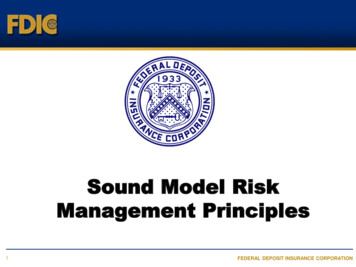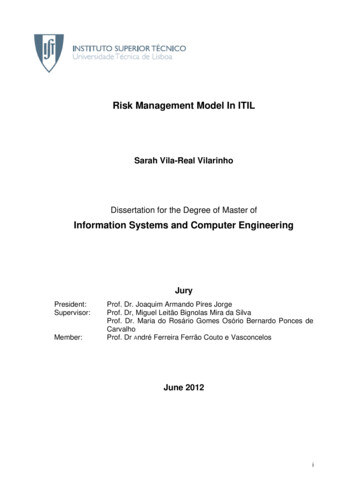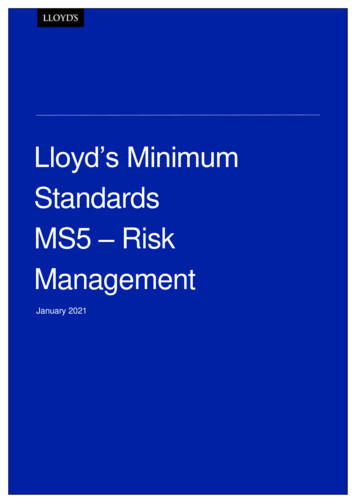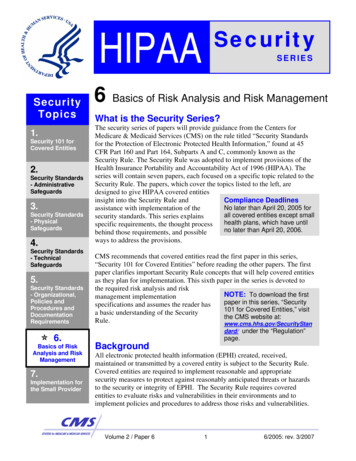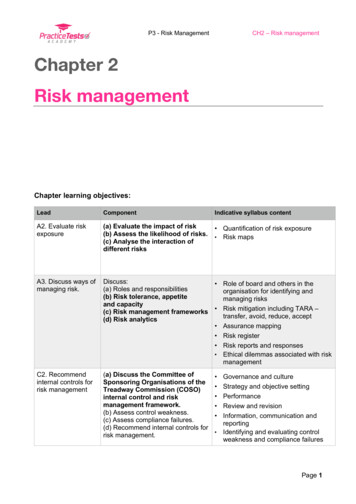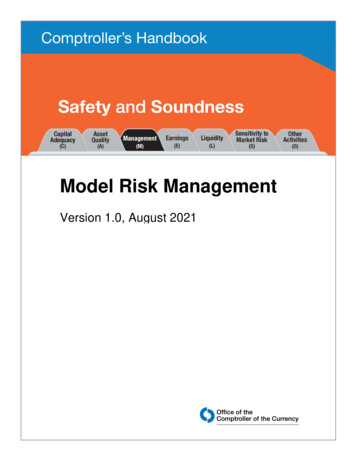
Transcription
Comptroller’s HandbookSafety and nt(M)Earnings(E)Liquidity(L)Sensitivity toMarket Risk(S)OtherActivities(O)Model Risk ManagementVersion 1.0, August 2021( ) Office of theComptroller of the Currency
Version 1.0ContentsIntroduction.1Background . 1Risks Associated With the Use of Models. 4Strategic Risk . 6Operational Risk . 6Reputation Risk. 7Compliance Risk. 8Credit Risk . 9Liquidity Risk . 9Interest Rate Risk. 10Price Risk . 10Risk Management .12Governance . 13Board and Management Oversight . 15Personnel. 16Model Owners . 17Independent Risk Management Staff . 18Internal Audit . 19Policies and Procedures . 21Risk Assessment . 24Planning . 25Model Inventory. 26Documentation. 28Data Management . 29Model Development, Implementation, and Use . 30Model Development and Implementation . 31Testing . 32Ongoing Development . 33Model Use. 33Model Overlays and Adjustments . 34Reporting . 35Model Validation . 36Evaluation of Conceptual Soundness. 39Ongoing Monitoring . 42Process Verification . 43Benchmarking . 44Outcomes Analysis . 45Back-Testing . 47Third-Party Risk Management. 48Third-Party Models and Data. 48Engaging Third Parties for Model Risk Management Activities. 50IT Systems . 51Comptroller’s HandbookiModel Risk Management
Version 1.0Examination Procedures .53Scope. 53Quantity of Risk. 55Quality of Model Risk Management. 58Conclusions. 82Internal Control Questionnaire .84Glossary .103References.105Comptroller’s HandbookiiModel Risk Management
Version 1.0IntroductionThe Office of the Comptroller of the Currency’s (OCC) Comptroller’s Handbook booklet,“Model Risk Management,” is prepared for use by OCC examiners in connection with theirexamination and supervision of national banks, federal savings associations, and federalbranches and agencies of foreign banking organizations (collectively, banks). Each bank isdifferent and may present specific issues. Accordingly, examiners should apply theinformation in this booklet consistent with each bank’s individual circumstances.This booklet aligns with the principles laid out in the “Supervisory Guidance on Model RiskManagement” conveyed by OCC Bulletin 2011-12, “Sound Practices for Model RiskManagement: Supervisory Guidance on Model Risk Management” (MRM SupervisoryGuidance). This booklet is designed to guide examiners in performing consistent, high-quality model riskmanagement examinations.presents the concepts and general principles of model risk management.informs and educates examiners about sound model risk management practices thatshould be assessed during an examination.provides information needed to plan and coordinate examinations on model riskmanagement, identify deficient practices, and conduct appropriate follow-up.Supervisory Guidance on Model Risk ManagementThroughout this booklet, information from the “Supervisory Guidance on Model RiskManagement” is identified in boxes like this one. Refer to OCC Bulletin 2011-12 for the full text ofthe supervisory guidance.Certain laws or regulations apply to specific models. 1 This booklet does not focus onspecifics regarding compliance with these laws and regulations, as this booklet’s focus is ona bank’s model risk management for all models. Model risk management should becommensurate with the extent and complexity of model usage at a bank.BackgroundSupervisory Guidance on Model Risk ManagementFor the purposes of this document, the term model refers to a quantitative method, system, orapproach that applies statistical, economic, financial, or mathematical theories, techniques, andassumptions to process input data into quantitative estimates. A model consists of threeFor example, certain banks must comply with ongoing model review, approval, and validation requirements aspart of the advanced approaches risk-based capital rules, set forth at 12 CFR 3, subpart E, and the market riskrule, set forth at 12 CFR 3, subpart F. Terms that are boldfaced upon first mention in this booklet are defined inappendix A of this booklet.1Comptroller’s Handbook1Model Risk Management
Version 1.0components: an information input component, which delivers assumptions and data to the model; aprocessing component, which transforms inputs into estimates; and a reporting component, whichtranslates the estimates into useful business information. Models meeting this definition might beused for analyzing business strategies, informing business decisions, identifying and measuringrisks, valuing exposures, instruments or positions, conducting stress testing, assessing adequacy ofcapital, managing client assets, measuring compliance with internal limits, maintaining the formalcontrol apparatus of the bank, or meeting financial or regulatory reporting requirements and issuingpublic disclosures. The definition of model also covers quantitative approaches whose inputs arepartially or wholly qualitative or based on expert judgment, provided that the output is quantitativein nature. (See note 1.)Note 1: While outside the scope of this guidance, more qualitative approaches used by banking organizations— i.e., thosenot defined as models according to this guidance—should also be subject to a rigorous control process.A model may combine assumptions, data, and hypotheses about the behavior of markets orindividuals, and process these inputs into quantitative estimates, forecasted outcomes, orpredictions.Supervisory Guidance on Model Risk ManagementModels are simplified representations of real-world relationships among observed characteristics,values, and events. Simplification is inevitable, due to the inherent complexity of thoserelationships, but also intentional, to focus attention on particular aspects considered to be mostimportant for a given model application. Model quality can be measured in many ways: precision,accuracy, discriminatory power, robustness, stability, and reliability, to name a few. Models arenever perfect, and the appropriate metrics of quality, and the effort that should be put intoimproving quality, depend on the situation. For example, precision and accuracy are relevant formodels that forecast future values, while discriminatory power applies to models that rank orderrisks. In all situations, it is important to understand a model’s capabilities and limitations given itssimplifications and assumptions.Because assumptions are typically simplifications of the actual relationships between inputsand outputs, and hypotheses about behavior are imprecise, there is some uncertaintyassociated with a model’s estimate of the outputs, resulting in prediction errors.Various models may focus on discriminatory power or predictive power as measures ofmodel accuracy. Discriminatory power assesses a model’s rank-ordering property, whilepredictive power focuses on the model output’s prediction accuracy. A model focusing ondiscriminatory power need not produce the most accurate prediction, in the same way amodel with the most accurate predictive power need not produce maximum rank-ordering.In contrast to a model, a quantitative tool not meeting the definition of a model described inthe MRM Supervisory Guidance may apply deterministic rules or algorithms 2 to processinformation and produce outcomes defined by the deterministic rules. For example, a toolAn algorithm is a set of computational rules to be followed to solve a mathematical problem. More recently,the term has been adopted to refer to a process to be followed, often by a computer.2Comptroller’s Handbook2Model Risk Management
Version 1.0can include spreadsheet calculations using algebraic formulas, such as summation, or valuesfor which the output is certain. Outputs produced by quantitative tools that are not modelsgenerally do not rely on sensitivity analysis or other methods to develop quantitativeestimates, forecasted outcomes, or predictions. The determination by a bank of whether aquantitative tool is considered a model is bank-specific, and a conclusion regarding the tool’scategorization should be based on a consideration of all relevant information. Riskmanagement should be commensurate with the extent and complexity of the quantitative toolused. Risk management for quantitative tools that do not meet the definition of a modeldescribed in the MRM Supervisory Guidance may be significantly less robust than riskmanagement for models.Supervisory Guidance on Model Risk ManagementBanks rely heavily on quantitative analysis and models in most aspects of financial decisionmaking. They routinely use models for a broad range of activities, including underwriting credits;valuing exposures, instruments, and positions; measuring risk; managing and safeguarding clientassets; determining capital and reserve adequacy; and many other activities.The expanding use of models in all aspects of banking reflects the extent to which models canimprove business decisions, but models also come with costs. There is the direct cost of devotingresources to develop and implement models properly. There are also the potential indirect costs ofrelying on models, such as the possible adverse consequences (including financial loss) ofdecisions based on models that are incorrect or misused. Those consequences should be addressedby active management of model risk.Models can help increase automation, transparency, and consistency of bank activities. Thenumber, scope, and complexity of models continue to increase over time. Examples of modeluses include underwriting and managing credits.valuing trading exposures.pricing.risk hedging.managing client assets.measuring compliance with- internally established limits.- laws and regulations (including consumer protection-related laws and regulations).estimating the allowance for credit losses (ACL) and capital adequacy.issuing public disclosures.preventing and detecting fraud and money laundering.The expanded use of models combined with their increasing complexity and value indecision making underscore the importance of sound model risk management. Additionally,Comptroller’s Handbook3Model Risk Management
Version 1.0the incorporation of alternative data 3 contributes to model complexity while expandingaccess to credit and producing benefits for consumers.Technological and analytical advances are contributing to increased model complexity anduse. For example, artificial intelligence (AI), 4 including machine learning, 5 is used in avariety of ways. AI is broadly defined as the application of computational tools to addresstasks traditionally requiring human analysis. Examples of AI uses in banks include frauddetection and prevention, marketing, chatbots, credit underwriting, credit and fair lendingrisk management, robo-advising (i.e., an automated digital investment advisory service),trading algorithms and automation, financial marketing analysis, cybersecurity, Bank SecrecyAct/anti-money laundering (BSA/AML) suspicious activity monitoring and customer duediligence, robotic process automation, and audit and independent risk management. Some AImay meet the definition of a model noted in the MRM Supervisory Guidance. While AIoutputs are not always quantitative in nature, AI is typically based on complex mathematicaltechniques. Regardless of how AI is classified (i.e., as a model or not a model), theassociated risk management should be commensurate with the level of risk of the functionthat the AI supports.Risks Associated With the Use of ModelsFrom a supervisory perspective, risk is the potential that events will have an adverse effect ona bank’s current or projected financial condition 6 and resilience. 7 The OCC has defined eightcategories of risk for bank supervision purposes: credit, interest rate, liquidity, price,operational, compliance, strategic, and reputation. These risks are not mutually exclusive.Any product or service may expose a bank to multiple risks. Risks may also beinterdependent and positively or negatively correlated. Examiners should be aware of andassess this interdependence. Examiners also should be alert to concentrations that cansignificantly elevate risk. Concentrations may accumulate within and across products,business lines, geographic areas, countries, and legal entities. Refer to the “Bank SupervisionFor more information, refer to OCC Bulletin 2019-62, “Consumer Compliance: Interagency Statement on theUse of Alternative Data in Credit Underwriting.” Examples of alternative data uses in modeling by banksinclude using enhanced assessments of repayment capacity, including cash flow data, to evaluate thecreditworthiness of consumers who currently may not obtain credit in the mainstream credit modeling system.3AI can be used for such tasks as natural language processing, predictive analytics, recommendation engines, orrecognition of images, patterns, or speech.4Machine learning, a subcategory of artificial intelligence, is a method of designing a sequence of actions tosolve a problem that optimizes automatically through experience and with limited or no human intervention.Refer to “Artificial Intelligence and Machine Learning in Financial Services: Market Developments andFinancial Stability Implications,” Financial Stability Board (November 2017).5Financial condition includes impacts from diminished capital and liquidity. Capital in this context includespotential impacts from losses, reduced earnings, and market value of equity.6Resilience recognizes the bank’s ability to withstand periods of stress. For more information on the riskassessment system, refer to the “Bank Supervision Process” booklet of the Comptroller’s Handbook.7Comptroller’s Handbook4Model Risk Management
Version 1.0Process” booklet of the Comptroller’s Handbook for an expanded discussion of banking risksand their definitions.Model use can affect risk in all eight categories of risk. The use of models can increase ordecrease risk in each risk category depending on the models’ purpose, use, and theeffectiveness of any relevant model risk management. Conceptually, model risk is a distinctrisk that can influence aggregate risk across all risk categories. Model risk can increase dueto interactions and dependencies among models, such as reliance on common assumptions,inputs, data, or methodologies.Supervisory Guidance on Model Risk ManagementThe use of models invariably presents model risk, which is the potential for adverse consequencesfrom decisions based on incorrect or misused model outputs and reports. Model risk can lead tofinancial loss, poor business and strategic decision making, or damage to a bank’s reputation.Model risk occurs primarily for two reasons: The model may have fundamental errors and may produce inaccurate outputs when viewedagainst the design objective and intended business uses. The mathematical calculation andquantification exercise underlying any model generally involves application of theory, choiceof sample design and numerical routines, selection of inputs and estimation, andimplementation in information systems. Errors can occur at any point from design throughimplementation. In addition, shortcuts, simplifications, or approximations used to managecomplicated problems could compromise the integrity and reliability of outputs from thosecalculations. Finally, the quality of model outputs depends on the quality of input data andassumptions, and errors in inputs or incorrect assumptions will lead to inaccurate outputs.The model may be used incorrectly or inappropriately. Even a fundamentally sound modelproducing accurate outputs consistent with the design objective of the model may exhibit highmodel risk if it is misapplied or misused. Models by their nature are simplifications of reality,and real-world events may prove those simplifications inappropriate. This is even more of aconcern if a model is used outside the environment for which it was designed. Banks may dothis intentionally as they apply existing models to new products or markets, or inadvertently asmarket conditions or customer behavior changes. Decision makers need to understand thelimitations of a model to avoid using it in ways that are not consistent with the original intent.Limitations come in part from weaknesses in the model due to its various shortcomings,approximations, and uncertainties. Limitations are also a consequence of assumptionsunderlying a model that may restrict the scope to a limited set of specific circumstances andsituations.Banks should identify the sources of risk and assess the magnitude. Model risk increases withgreater model complexity, higher uncertainty about inputs and assumptions, broader use, and largerpotential impact. Banks should consider risk from individual models and in the aggregate.Aggregate model risk is affected by interaction and dependencies among models; reliance oncommon assumptions, data, or methodologies; and any other factors that could adversely affectseveral models and their outputs at the same time. With an understanding of the source andmagnitude of model risk in place, the next step is to manage it properly.Comptroller’s Handbook5Model Risk Management
Version 1.0The risks associated with model use can occur at any point during a model’s development,implementation, use, and validation. A bank’s risk profile can increase depending on amodel’s complexity, the technologies used to implement models, higher uncertainty aboutinputs and assumptions, broader model use, larger potential impact on the bank’s financialcondition or compliance with laws and regulations, and weaknesses in model governance. Itis important to consider risk from individual models and in the aggregate.Inaccurate measurement of risk or relying on models that are not used as originally intendedcan result in poor decision making. Without proper model risk management, model inputerrors, inaccurate assumptions, and untimely or missing validations can result in riskmeasurements that are inaccurate or misrepresented, and therefore board and managementdecisions that are based on inaccurate or irrelevant model outputs. More generally,inadequate governance over models’ development, implementation, use, and validation canincrease risk. It is important for a bank’s decision makers to understand a model’s limitationsto avoid using a model in ways not originally intended or if the model has not been validated.Strategic RiskStrategic risk is the risk to current or projected financial condition and resilience arising fromadverse business decisions, poor implementation of business decisions, or lack ofresponsiveness to changes in the banking industry and operating environment.The board of directors and senior management are the key decision makers that drive thestrategic direction of the bank and establish a governance framework for using models. Theabsence of an appropriate governance framework for developing, implementing, using, andvalidating models poses strategic risk. A bank’s strategic risk can increase if models andassociated risk management do not keep pace with strategic changes, the capability ofemployees, the operating environment, and regulatory requirements. For example, failure toadjust model inputs and assumptions for current and anticipated market conditions, themacroeconomic environment, and consumer behaviors could expose the bank to strategicrisk, which may translate into financial losses.Operational RiskOperational risk is the risk to current or projected financial condition and resilience arisingfrom inadequate or failed internal processes or systems, human errors or misconduct, oradverse external events.Operational risk is the primary risk associated with the use of models. Failed or inadequateprocesses and systems and errors or misconduct by personnel can significantly affect thepredictive value of a model. Operational risk can result from fundamental errors in a modelwhen viewed against the design objective and intended business uses without sufficient useof model overlays 8 and adjustments when model limitations become apparent. Personnelwho do not have sufficient skills and training to develop, implement, use, and validate theA model overlay is a judgmental or qualitative adjustment to model inputs or outputs to compensate formodel, data, or other known limitations. A model overlay is a type of override.8Comptroller’s Handbook6Model Risk Management
Version 1.0bank’s models can increase operational risk. Modeling errors or omissions can occur in theapplication of theory, data inputs, algorithms, assumptions, shortcuts, simplifications, andapproximations, which can lead to inaccurate outputs.Management’s failure to engage in appropriate model risk management to prevent errors andimproper use of models can increase operational risk. For example, operational risk canincrease when algorithms are based on biased, insufficient, incomplete, or inaccurateinformation, or are not properly tested and validated. Models can fail because of inadequateinternal controls, such as insufficient processes for controlling the quality of the data inputs.The absence of an appropriate change management process for new technologies, products,or service offerings related to models can also increase operational risk.Operational risk can increase when the information technology (IT) environment supportingthe bank’s models does not have appropriate internal controls. Security weaknesses,including poorly constructed application program interfaces (API) 9 and weaknesses in thecontrols for the access, transmission, and storage of sensitive customer information, couldexpose a bank to increased operational risk. Weak or lax controls can compromise theconfidentiality or integrity of sensitive customer data.Third-party risk management weaknesses related to a bank’s use of third parties providingmodels or related products and services could increase operational risk, particularly whenmanagement does not fully understand a third-party model’s capabilities, applicability, andlimitations. New technologies, products, and services, such as AI and data aggregation, canincrease third-party access to banks’ IT systems. When a bank allows third parties to connectto the bank’s models and systems and to access customer information, there can besubstantial operational risk. Poorly drafted contracts could increase operational risk.Important considerations include the ability of the third party to resell, assign, or permitaccess to the bank’s data and IT systems to other entities and how the data will betransmitted, accessed, and used.Reputation RiskReputation risk is the risk to current or projected financial condition and resilience arisingfrom negative public opinion. Reputation risk may impair the bank’s competitiveness byaffecting its ability to establish new relationships or services, or continue servicing existingrelationships.Inadequate policies and processes, operational breakdowns, or other weaknesses in anyaspect of model risk management or governance can increase reputation risk. A bank couldincur reputation risk from biased data outcomes, data losses, noncompliance with regulations,fraud, downtime, and insufficient consumer protections. Biased data outcomes can result inpotential disparate treatment or disparate impact on borrowers on a prohibited basis. Thirdparty risk management weaknesses and wrongful acts by third parties could increaseAPI is software code that allows two or more programs to communicate with each other. For moreinformation, refer to the Federal Financial Institutions Examination Council’s IT Examination Infobase’sGlossary.9Comptroller’s Handbook7Model Risk Management
Version 1.0reputation risk. A sound corporate culture is the foundation of a sound governanceframework and helps form a positive public perception of the bank.Compliance RiskCompliance risk is the risk to current or projected financial condition and resilience arisingfrom violations of laws or regulations, or from nonconformance with prescribed practices,internal bank policies and procedures, or ethical standards.Compliance risk is elevated when banks do not comply with model-related laws andregulations. For example, risk-weighted asset regulations dictate requirements for certainbanks’ capital measurement models. 10 Compliance risk is also elevated when models resultin potential discrimination on a prohibited basis or other violations of consumer protectionrelated laws and regulations.A bank’s compliance risk can increase when models used in the bank’s BSA/AML 11 andOffice of Foreign Assets Control (OFAC) programs inaccurately reflect the risk of a bank’sbusiness model, products, services, customer base, and geographic footprint. One example issetting and tuning thresholds in a BSA/AML or OFAC model without taking differences inrisk levels across lines of business, products, services, customer types, and geographies intoaccount. 12A bank’s fair lending compliance risk could increase when a bank’s credit decisioningmodels include algorithms, variables, or other processes that result in disparate impact oncredit applicants or customers based on prohibited factors, such as race, ethnicity, or sex. 13The source of the bias may be obscured by the model’s complexity if management does notproperly understand a
Model Risk Management Version 1.0, August 2021 Capital Office of the Comptroller of the Currency Comptroller's Handbook Safety and Soundness Management (M) . detection and prevention, marketing, chatbots, credit underwriting, credit and fair lending risk management, robo-advising (i.e., an automated digital investment advisory service),

